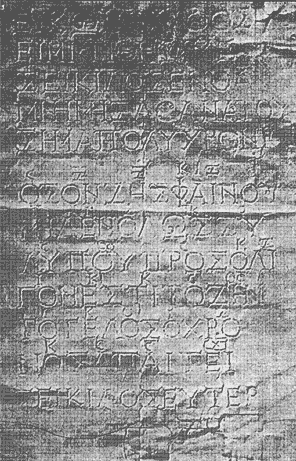- Music Information Activities
- News
- Current weekly Newsletter (in Greek)
- Newsletters Archive (in Greek)
SYSTEM
The musical system of the ancient Greeks was created gradually. Originally, it was more likely a five-tone system, that is, a scale had only five levels (like the one existing in Epirus to this day). The addition of two more notes in the scale in the 8th century changed it to a seven -tone system. The tone system of ancient Greece constitutes the base of later tone systems and even the contemporary.
Note names- Tetrachords
The music system in ancient Greece was based on the lyre because that was their main musical instrument:
- The names of the notes correspond to the names of the lyre's chords
- The scales were gradually falling just like the chords when the organ was held.
- The scales consist of two groups made up of four chords named "tetrachorda".
The names of chords and notes were:
In the trichord:
- Niti (=the lowest), corresponding to Mi.
- Mesi (=middle), corresponding to La and
- Ypati (=topmost), corresponding to Mi.
The chords added were:
- Paramesi (after the middle), corresponding to Si
- Paraniti (before the niti), corresponding to Re and later on
- Lichanos (=of the index finger), placed before the middle and corresponding to Sol.
Last added:
- Triti (=third), corresponding to Do
- Parypati, corresponding to Fa
These additions created a full diatonic scale.
They used the natural method of tuning and not the tempered. Tones and semitones were not all equal but slightly differed according to position. The combination of tones and semitones created three tetrachords. Each tetrachord was named according to its origin.
|
δώριο
|
φρύγιο
|
λύδιο
|
|
Η - Τ - Τ |
Τ - Η - Τ |
Τ – Τ - Τ |
Modes
The system's characteristic is the use of seven modes, called harmonies and not only two as in the western tone system of major and minor. The mode did not only define the scale but also the manner (style) in which the song was to be played. Each mode had two tetrachords linked to a tone. Thus, the following modes were established:
|
Δώριος
|
Μι - Μι |
|
Φρύγιος
|
Ρε - Ρε |
|
Λύδιος
|
Ντο - Ντο |
|
Υποδώριος ή Αιόλιος |
Λα-Λα
|
|
Υποφρύγιος ή Ιόνιος |
Σολ – Σολ |
|
Υπολύδιος
|
Φα – Φα |
|
Μιξολύδιος
|
Σι – Σι |
In ancient Greece there three standard tunings, known as genus (the diatonic, chromatic and enharmonic) which altered the pitch of notes and therefore of the tetrachords. An example of this is shown below.

The enharmonic tetrachord, as you can notice from the figure above, used quarter notes as well in order to attribute color.
Notation
There were two types of notation (parasemantics) the vocal and the instrumental.
Their principles were simple. The vocal used letters of the Ionian alphabet (which is similar to the contemporary Greek alphabet) corresponding to a specific pitch.
Each note is represented by a letter in its original form, the following letter corresponds to the first pitch (alteration) and the next one corresponds to the second pitch. The next note follows (lower).
In the instrumental notation, the letters of a different local alphabet are used (probably Argeian), revolving for each pitch. This notation was in use until the 3rd century BC when it was replaced by neumatic (gesticular).



 Hellenic
Hellenic  English
English